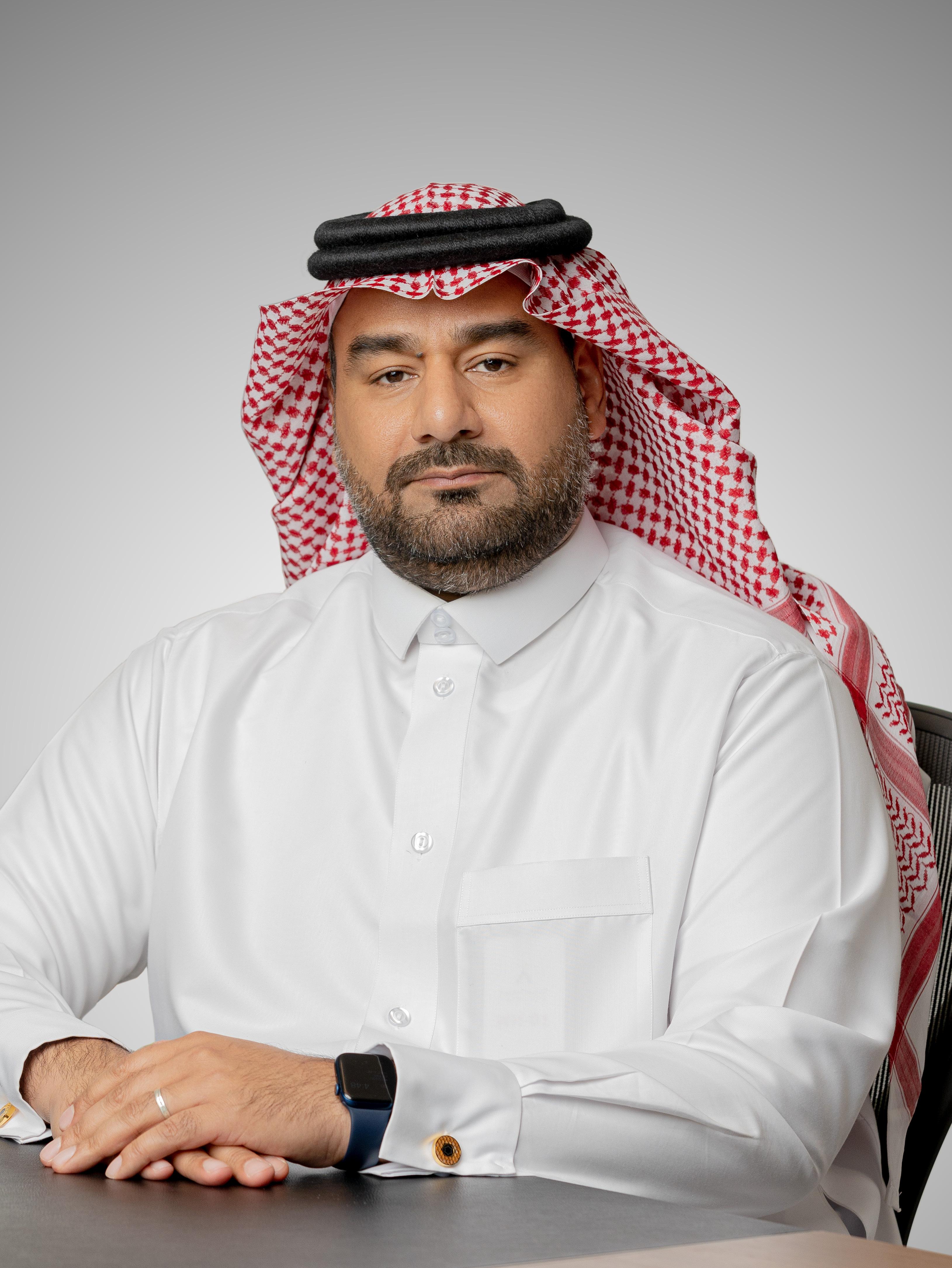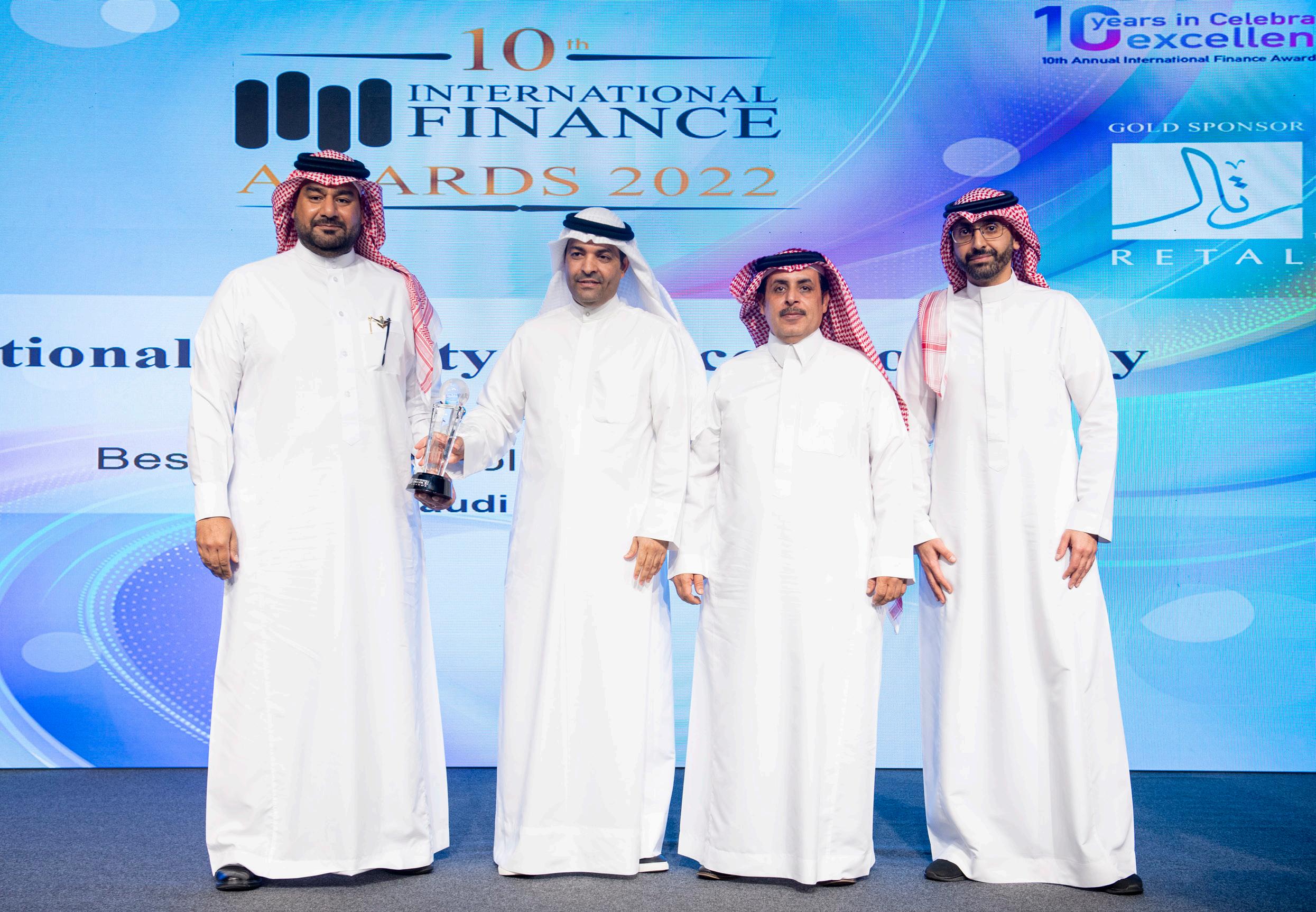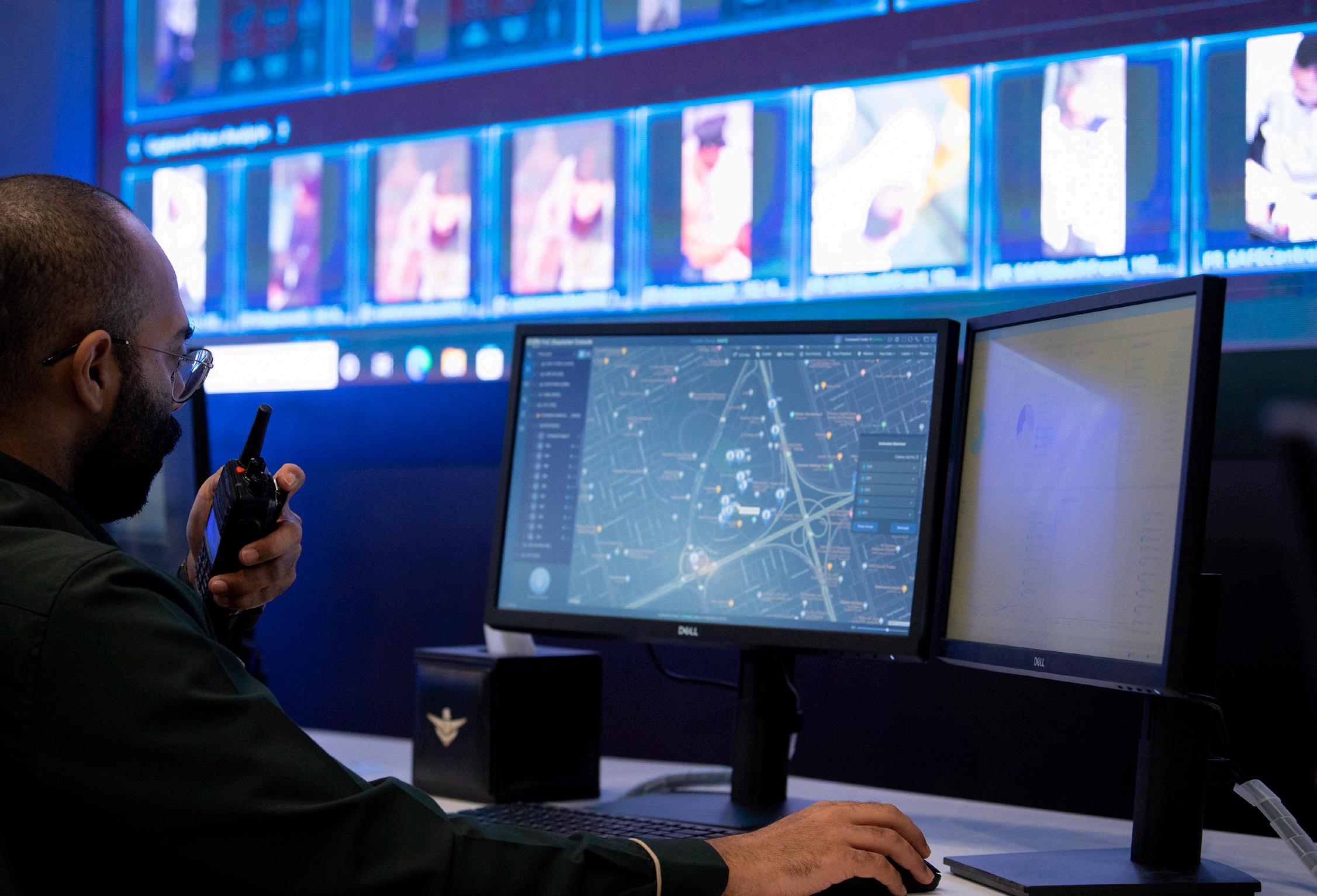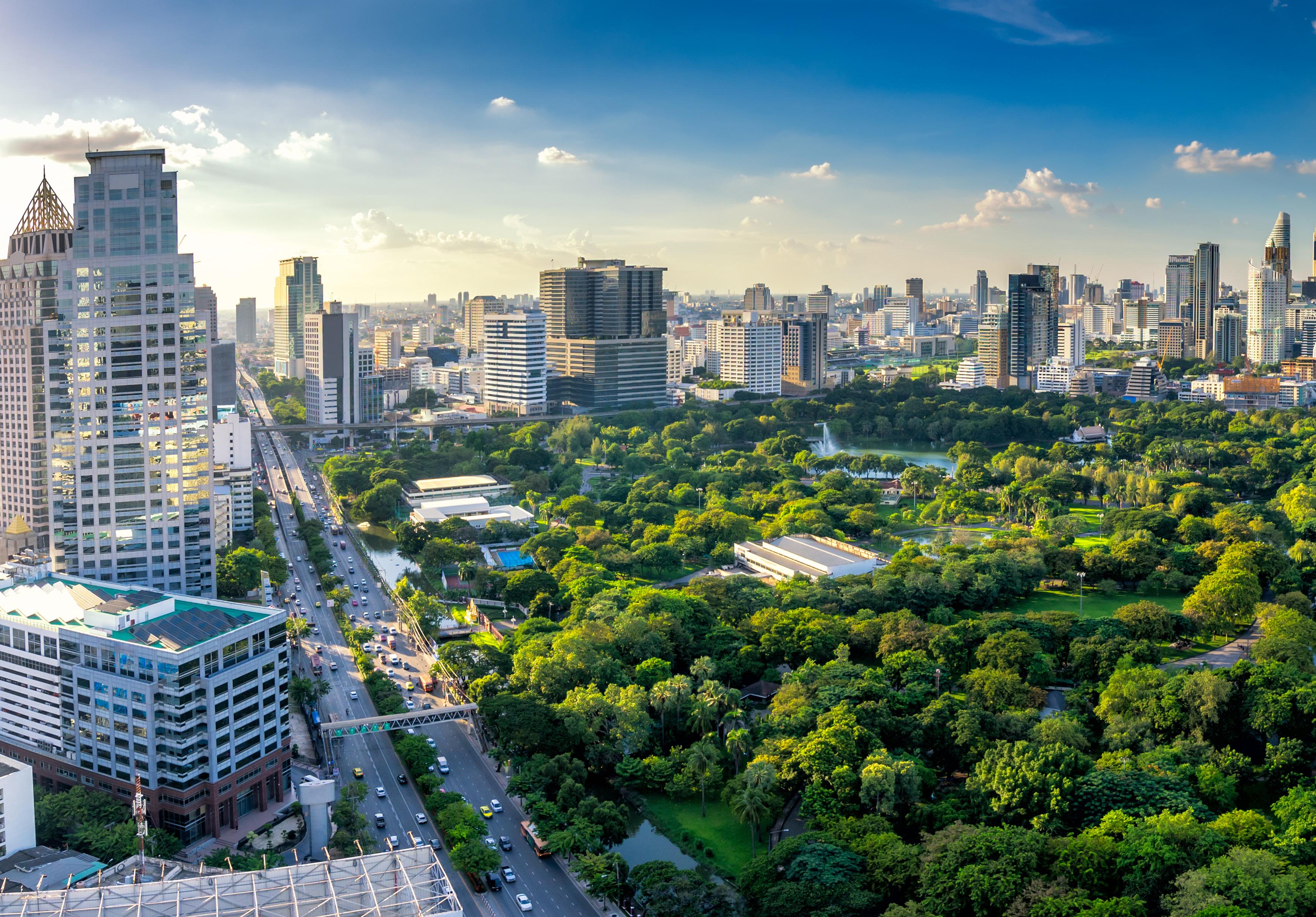
13 minute read
SAFE:
SAFE provides top-notch security consulting to its clients and partners through innovative measures

IF CORRESPONDENT
GCC’s trusted security partner
With a mission to promote and transform the security services sector through a consultative approach, SAFE has been changing client perceptions and future expectations by offering best-in-class security solutions, while combining world-class technology with the expertise of well-trained and distinguished security personnel.
SAFE has four business objectives: Direct uplifting of Saudi's security industry, maximising the integration of security elements, supporting national security initiatives, and creating a commercial sustainable platform.
“Our ambition at SAFE, is to be a trustworthy and honourable front of our country, society, and entities that we protect. Through promoting integration between the qualified individuals and the latest technology and security solutions, as well as legislations aiming to meet our customers’ safety aspirations and needs by integrated security solutions," remarked SAFE CEO
Turki Bin Matooq Althonayan.
Knowing A-Z of SAFE
SAFE's primary goal is to develop and upgrade the quality and service provided in private civilian security in the Kingdom, with the help of an executive and professional team with extensive experience and successes in the security field. The end target is to ensure that clients understand their security requirements accurately and induct solutions as per those needs.
SAFE provides top-notch security consulting to its clients and partners through innovative measures, while also bringing experts on board to draw up solutions in the private security sector. SAFE branches are deployed in the Kingdom's major cities as part of its strategy of being close to clients.
SAFE also focuses on providing integrated security services with technical and continuous training and supporting security staff in the field through SAFE Reginal Control Center (SRCC), in order to guide them and monitor their performances on an ongoing basis.


In June, 2021, SAFE signed various MoUs in the fields of aerospace and defence, in order to advance integrated security solutions in the Kingdom. The agreement has established a framework for the creation of command centres for security, development of training services including high-technology security and operations, as well as providing security consultations in the country.
The company is now working closely with international industry partners and key players to strengthen the Kingdom’s capacity in delivering integrated security solutions.
Talking about SAFE's specialisation, the venture has a professional advisory and consultancy team which provides conceptual advisory and technical solution designs across a range of complex and highrisk environments. The team comprises technically accomplished and independent professionals, who bring their prior experiences of working in successful security programs to the table.
Armed with the knowledge of emerging technologies and best industrial practices, SAFE professionals help their clients to transition into efficient and reliable automated security services.
SAFE's core security consultancy elements are 'Risk Mapping', 'Security Master Plan Design', 'Implementation' and 'Oversight'.
SAFE is eager to minimise your future risks and threats through our trusted advisors and consultants to provide you with integrated solutions to overcome your security challenges," remarked by the GM of Advisory and Consulting Mustafa M. Jan, while describing its 'Comprehensive Consultancy Approach'.
The approach involves three stages: ‘Conceive Security Design’ (where the blueprints for the master planning and security architecture design get done for the clients), ‘Site Assessment’ (process containing effective and comprehensive reviews of client's business assets and drawing up threat and risk management mechanisms) and ‘Build and Integrate’ (The final stage involving integration and convergence of security mechanisms at the client's premises, apart from the routine project management functions).
SAFE has displayed a demonstrable, proven track record of providing consultancy services to a wide range of projects across the sectors like smart cities, air and seaports, government services, residential and commercial property markets, and last but not least, sports and mass events.
SAFE's security solutions
"SAFE believes in meeting and exceeding customer expectations. We understand that as a business-to-business service; managing all perspectives of quality, brand, and cost can be an enormous task, hence; there is always room for improvement and the key to success is the commitment to continual development. This is achieved through the integration of state-of-theart technology, careful selection of staff, extensive training, dedicated account management, and layers of communication channels. We are always keen to listen to our clients, and their customers about their SAFE Experience," the company commented.
SAFE's security professionals undergo extensive screening and intensive training, as part of their certification process. Armed with the latest radio communication devices, and non-lethal weapons according to the client’s/ project’s risk level, these professionals follow best practices as per international standards.
SAFE's specialised security offerings for clients include 'SAFE Cash Management Services', 'K-9 Services', 'Events Security Services', 'Maritime Security', 'Fire & Safety Services' and 'VVIP Protection'.
Exploring SAFE Reginal Control Centre (SRCC)
Manea Al Shetawi, Chief Operations Officer, said, “For any operation to be successful, one of the key elements is effective communication. The faster the information is exchanged, the quicker the response in terms of resolving an incident, accident, or any issue for that matter. As such, the establishment and operation of a SRCC is deemed an absolute essential, to enable us to deliver our concept of Security Solutions. The SRCC being an integral part of SAFE, supports the business operations as well as provides cost-efficient and technically reliable services to our clients. It is designed to manage services from one platform and can perform multiple functions.”
Fahad Al Ghamdi, Head of Command & Control Centre, said, “Our Reginal Control Center is linked to the client’s security tech infrastructures with a backup service for onsite Security Operation Center (SOC) to provide 24/7 coverage by monitoring with real-time information feeds around the clock, latest technologies including CCTV cameras and unmanned systems (both aerial and ground), sensor-tracking systems and intrusion detection, as well as life safety equipment, linkage with first responders and relevant authorities and patrol vehicles tracking.”

How SAFE trains its employees?
Candidates go through rigorous training at the SAFE academy, before being certified and
Our ambition at SAFE, is to be a trustworthy and honourable front of our country, society, and entities that we protect. Through promoting integration between the qualified individuals and the latest technology and security solutions, as well as legislations aiming to meet our customers accredited for the job as per international standards.
SAFE is licenced by International Federation of Protection Officer (IFPO) to provide international accredited courses in various languages (Arabic, English and other).
"The fast-changing threat and risk spectrum necessitate skills enhancement for security professionals to remain future fit, as well as, abreast of industry best practices," commented SAFE on its staff training program, while continuing, "With an intent to enhance competency and service standards for the security industry in the Kingdom, we have partnered with global organizations for the bringing state of the art education and training resources for our staff and those of our business partners i.e., the clients."
SAFE’s security professionals get three layers of training, namely fundamental, specialised and supervisory, thus covering all the bases as per the industry requirements. Its tailored curriculum, training methodologies, world-class expertise, and purpose-built facilities transform the Saudi Nationals into top notch professionals equipped with the skills to meet the industry demands.
Some of the certificate courses in SAFE Academy include:
Certified Protection Officer (CPO): This course is designed for security officers and aspirants who wish to learn more about security/asset protection strategies and emerging trends.
Certified in Security Supervision & Management (CSSM): This course is designed to match the job descriptions of the security supervisor/ manager. The program is suitable for those wanting to advance their career in security and earn leadership roles in that particular hierarchy.
Certified Protection Professional (CPP): This one provides knowledge and management skills in seven key domains. It gives the candidate a true competitive advantage, enhancing career opportunities and performance.
Physical Security Professional (PSP): A course designed to conduct physical security surveys to identify vulnerabilities and perform cost analysis for the selection of integrated physical security measures.
SAFE's Roadmap for 'Vision 2030'
The incorporation of the company was part of the investment strategy of Saudi Public Investment Fund (PIF), with the goal of contributing to the objectives of diversifying the Kingdom's economy under 'Vision 2030', through the development of promising sectors.
"SAFE will contribute to achieving PIF's effort to build a diversified local and international investment portfolio that will enhance the strength of the Saudi economy, diversify sources of income, and achieve long-term economic returns for KSA and its citizens, in order to reflect the Kingdom's vision 2030, as it will support the empowerment of the private security sector in KSA, the localisation of knowledge in this sector and the provision of jobs, in addition to supporting small and mediumsized companies,” the company stated, while talking about its roadmap of contributing to the goals of 'Vision 2030'.
"SAFE is taking care of its employees in order to provide quality and care to its clients. In this aspect, the company is offering programs that ensure continuity and the accumulation of knowledge for security personnel, including: Clear career paths, Social Insurance, Medical Insurance, Certified and Continuous Training and Compensation," it added further.

"SAFE was established to achieve three dimensions: the urgent need for some security sectors, those to which the private sector does not contribute, and the reinforcing of the role of privatisation, i.e., the conversion of some private enterprises. SAFE will focus on four key points: Security consultancy because any security work begins with a good risk assessment, then we move on to the integration that will occur from an operational or technical aspect through the SRCC to respond and monitor any event. The third point is internationally approved training and development, and finally, security solutions, and we will seek to develop the remaining part, not only providing the service, but also supporting the owners of current companies to contribute by providing them with a supporting layer in this sector," the company remarked.
SAFE has a commitment to contribute and empower the Kingdom's private security ecosystem by transforming it into an attractive
SAFE has a commitment to contribute and empower the Kingdom's private security ecosystem by transforming it into an attractive profession for the citizens, a profession which will enable the Saudi youth to have clear career path, with state-of-the-art training and qualification opportunities profession for the citizens, a profession which will enable the Saudi youth to have clear career path, with state-of-the-art training and qualification opportunities. editor@ifinancemag.com

"We are working on ensuring that this goal is achieved by adhering to a number of elements, first, the selection of our employees carefully according to the highest security standards. The recruitment process goes through setting high standards in proportion to the requirements of clients, and through the stages of behaviour and appearance tests and personal interviews, then a security survey and medical examination. Followed by the training of our staff at the best security institutes, where our employees are given intensive training," SAFE elaborated further, while talking about implementing programs that ensure the continuity and Knowledge accumulation for security officials, so that they can look after the client with less supervision.
Is Thailand environmentally sustainable?
If Correspondent
According to Germanwatch, an independent development and environmental organisation, Thailand is ranked ninth in the "extreme risk" category of countries that are most vulnerable to the effects of climate change over the next 30 years. Thailand is highly vulnerable to the effects of climate change. The nation is threatened by rising sea levels, which pose a threat to Bangkok, the nation's capital, which is on average 1.5 metres above sea level. Thailand's 6% of GDP and 30% of all jobs are in the agricultural industry. Therefore, extreme and unpredictable weather patterns, such as drought and flooding, are crucial, especially for the rural population.
Around less than 1% of the world's emissions come from Thailand, and per-person emissions are lower than average, but recent years have seen an increase in air quality-related worries. Thailand's carbon dioxide (CO2) emissions increased by 0.8% yearly from 2011–21, which is greater than the global average of 0.6% but still less than the Asia–Pacific average of 1.8%, according to statistics from the BP Statistical Review of World Energy 2022.

The International Energy Agency predicts that CO2 emissions will reach their peak before 2030. Thailand gains from having a large portion of the service sector, which produces less pollution than industry. Nevertheless, 36% of Thailand's CO2 emissions were from power generation, followed by industry (30%) and transportation (28%). This highlights Thailand’s need to diversify the energy source of its manufacturing industry by moving away from fossil fuel-based power, as well as expanding the fleet of low carbon transport.
Thailand continues to be heavily dependent on fossil fuels. The country's energy use was strongly skewed towards oil and natural gas, which together accounted for 77% of all energy consumption in 2021, according to data from the BP assessment. Overall energy consumption includes coal at 17%, which is low compared to the average for Asia-Pacific at 47%, which was mostly driven by high usage in China (55%), India (57%) and Indonesia (39%). Similar to regional peers, renewable energy consumption took up only 6.3% of the total, but between 2011 and 2021, it increased significantly, averaging 18% annually.
A sense of urgency is rising
Thailand does not have a good track record when it comes to committing to sustainability goals and combating climate change. The nation has a history of demonstrating insufficient commitment despite having strong intentions, according to the Climate Efforts Tracker, a research organisation that tracks government efforts to prevent climate change. The Thai government most recently established targets for carbon neutrality by 2050 and a net-zero GHG emission target in 2065 at the Glasgow UN Climate
Change Conference in 2021, ranking Thailand among the laggards. It did not sign an agreement to end deforestation by 2030.
However, there are indications that the situation is becoming worse. The rise in gas and oil prices brought on by the conflict in Ukraine and the political unrest in Myanmar—Thailand's main natural gas supplier—add the need to increase renewable energy in the mix, in addition to the concern for the environment.

A noticeable policy change towards a more ambitious goal and higher priority for the promotion of sustainable practice became apparent in 2022. Thailand's second updated nationally determined contribution, which included a more aggressive goal to cut its greenhouse gas emissions by 30%–40% from the predicted business-as-usual level by 2030, was revealed in November 2022. The Thailand government also announced a revised version of its Long-Term Low Greenhouse Gas Emissions Development Strategy, which proposed accelerated efforts to combat greenhouse emissions.
In response to worldwide criticism of Thailand's lack of action, the BCG model, in place since
Insight Thailand Climate Change Industry
Solar photovoltaic installed capacity
Total renewable energy installed capacity
2021, attempts to demonstrate a better public commitment to climate change risk and sustainability. During the meeting of the Asia-Pacific Economic Cooperation in November 2022, it was given a more prominent position as a cornerstone of economic policy. The government's initiatives actually concentrate on four economic sectors: food and agriculture, health care and wellness, energy, materials, and biochemicals, as well as tourism and the "creative" economy. In order to increase interest in the industries where Thailand currently has an edge, the BCG policy effort blends Thailand's sustainable drive with an investment promotion policy. The Climate Change Act, which is now in draught form, is another measure that suggests that change-related actions have advanced.
Regulators are also developing finance industry policies to assist sustainable practices. The Securities Exchange Commission and the Bank of Thailand, the country's central bank, are currently working on the Thailand Taxonomy, a set of standards that will serve as the foundation for a system of sustainable financial services and the development of related products.
Thailand's solar energy market
The Thai solar energy market is anticipated to grow at a CAGR of 8.5%, between 2022 to 2027. The COVID-19 pandemic slightly affected the solar photovoltaic (PV) installations in the country during Q1 and Q2 of 2020, but due to lockdown limitations, supply chain disruptions, decreased solar PV output, and delayed project implementation. The 45 MW floating solar farm's operation was delayed by the government-run Electricity Generating Authority of Thailand (EGAT). During the projection period, the solar energy market in Thailand is anticipated to be driven by elements such as significant government support for solar power development in the form of feed-in tariffs, the Alternative Energy Development Plan (AEDP), and falling prices for solar PV systems.
The ground-mounted solar PV category holds the largest proportion of the country's solar energy market due to the installed capacity of ground-mounted solar PV and the huge number of forthcoming projects in Thailand. The region is anticipated to increase the chances for solar energy firms to develop solar PV facilities over the next few years because it has an aim of decreasing GHG emissions to 20.8% by 2030. Additionally, the area has ambitions to lessen its reliance on foreign fossil fuels like crude oil and use renewable energy sources like solar to cut costs associated with imported oil. The market is also driven by favourable
GDP from the electricity, gas, steam, and air conditioning supply sector Thailand crude oil production
Thailand's reliance on fossil fuel
government policies, particularly those developed by the Ministry of Thailand to promote the production of electricity based on renewable resources.
The solar PV segment is predicted to hold the greatest market share during the projection period due to the decreasing cost of solar modules and the ability of these systems to be used for a variety of purposes, including the production of electricity and water heating.
The installed solar PV capacity in Thailand increased from 1,420 MW in 2015 to around 2,983 MW in 2020, according to the International Renewable Energy Agency (IRENA), registering a growth of almost 11% over the course of the year. Large-scale solar PV installation deployments in India, notably for utility projects, are to blame for the growth. The Indian government intends to boost installed solar PV capacity as well.
Meanwhile, a 12 MW solar rooftop PV project was launched by BCPG Public Company Limited (BCPG) in 2020 and is situated on the roof of Chiang Mai University in Thailand. In December 2021, Dezhou Dingzhuang floating solar photovoltaic park's second phase (120 MW) was connected by Huaneng Power International Inc. The plant has a 320 MW installed capacity overall, and the project can produce about 550 million kWh of power annually.
New opportunities in renewable energy sectors
The pathway to carbon neutrality and net zero will be challenging and will require a strong political will to see it through. According to a report by Economist Intelligence, Thailand should create an energy transition plan for the transport and energy sectors in particular. The country's power sector, which accounts for the majority of its emissions, has to shift away from natural gas (coal's role has already diminished over time) and towards renewables, particularly solar and wind in the long term. The transformation requires new infrastructure, including grid management, energy storage, and efficiency enhancement. If fossil fuels are used for direct consumption, Thailand's heavy industries and manufacturing sectors that are export-oriented will also need to increase their energy efficiency.
Thailand will need to increase the effectiveness of its public transport system and encourage electrification through infrastructure, such as charging stations, as well as financial incentives for consumers and also have to reduce emissions from the agricultural sector.
ANALYSIS CHINA JACK MA INDUSTRY
From 2020 to 2021, private flights nearly tripled and emissions more than quadrupled










